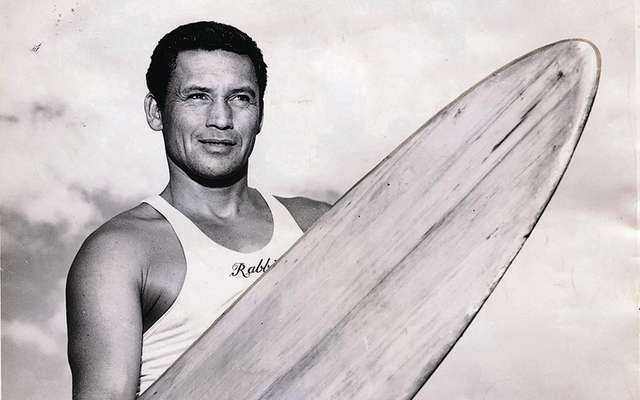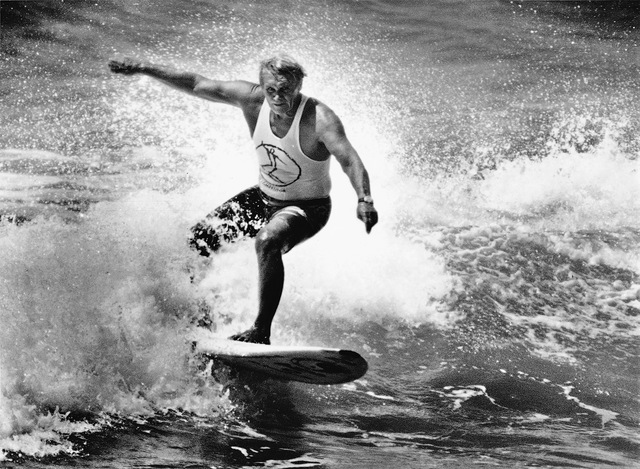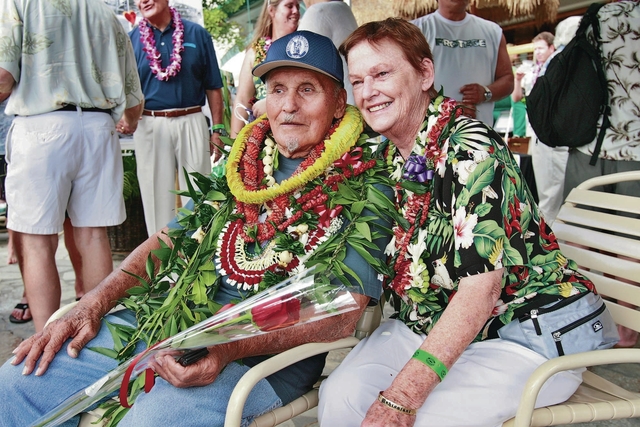Photo gallery of Rabbit Kekai
Waikiki surfing luminary Rabbit Kekai, known as the father of modern “hotdog surfing” who as a beachboy worked closely with the late Olympic champion Duke Kahanamoku, died Friday morning at Leahi Hospital. He was 95.
“It’s an end of an era,” said Randy Rarick, a co-founder of the Triple Crown of Surfing.
Born in Kalihi, Albert Kekai got his nickname “Rabbit” for his jackrabbitlike sprints at school.
He began surfing before he was 5 years old — when tourism was in its infancy in Hawaii and the only hotel on Waikiki Beach was the Moana. The Royal Hawaiian hadn’t been built.
Kahanamoku, who won three gold medals and two silver medals in Olympic games and worked as a beachboy in Waikiki, became a major influence in Kekai’s life.
Beachboys like Kahanamoku and Kekai served as the ambassadors of aloha for the budding visitor industry, encouraging guests to return to the islands.
Kahanamoku singled out Kekai as a trainee and took him out on a two-man canoe, showing him how to steer through breaks in the reef off Waikiki.
Rarick said Kekai was one of the last beachboys trained by Kahanamoku, known as the “father of surfing.”
Kekai witnessed major innovations in surfing.
Friends said before surfboards were made of fiberglass over foam and considerably lighter, Kekai was riding a short, finless wooden board in Waikiki.
A narrower tail and rail give the “hot curl” surfboard more maneuverability, allowing it to enter into the curl of the wave.
Then World War II came, and Kekai went into the Navy as an underwater demolition expert in the Pacific theater.
The assignments were dangerous. He recalled that before an invasion, as part of the demolition team, he would explode steel barriers that would prevent troop landing crafts carrying Americans from coming ashore.
After World War II, Kekai was one of the founding members of the Waikiki Surf Club, established in 1948 to provide a place to store surfboards and beach equipment and to shower.
In the 1950s, celebrities who came to Hawaii eventually found themselves on Waikiki Beach.
Kekai recalled teaching movie stars how to surf, including Red Skelton, Gregory Peck and Kirk Douglas.
“He was on the beaches of Waikiki during the romance era of the 1950s,” said Fred Hemmings, former state senator and a Makaha surfing champion. “Rabbit was one of the best when it came to surfing and canoe padding.”
Hemmings said Kekai and Richard “Buffalo” Keaulana were also the kings of Makaha surfing.
Kekai won not only men’s surfing events, but also tandem surfing contests at Makaha.
“He was one of the greats at Makaha,” Hemmings said.
Surfers said Kekai also had a major influence on promoting Hawaiian water sports, teaching some like Rarick to surf at age 10 and others like Hemmings to steer a canoe.
Hemmings said Kekai had his own style of surfing, moving quickly up and down the wave and cutting back to change directions, this at a time when most surfers were satisfied to just catch a wave and stay on it.
Surfers talked about how Kekai could dash to the front of the surfboard and hang five or all 10 toes off the front edge while maneuvering across the face of the wave.
His style of surfing, requiring quick-footed maneuvers, became known as hotdogging and became popular in Hawaii and California.
Kekai shared his knowledge of surfing with a number of surfers, including Donald Takayama, who moved from Hawaii to California in the 1950s and eventually won a number of international surfing contests.
In the late 1960s and early 1970s, the short surfboard with a leash became popular, and surfboards went from 10 feet to six feet, allowing more speed.
Kekai preferred using the traditional longboard with its increased flotation and ease of catching Waikiki waves.
Surfers recalled how Kekai was happy working as a beachboy and reached out to teach people about Hawaiian ocean sports.
“He was a man of aloha,” Hemmings said. “He always had a smile on his face.”
Into his 90s, Kekai could be seen occasionally working with beachboys near the Moana Surfrider.
He was less likely to be on the beach when the surf was up.
As one beachboy said, with Kekai’s kupuna status, “He works when he wants.”
Kekai supported the sport of surfing through promoting competitions, including the Rabbit Kekai Keiki Surfing Contest at Queen’s Surf Beach in the summer.
He also served as beach master for the Triple Crown of Surfing.
His daughter Kelli Huddy said Kekai was at Leahi Hospital for about a year and a half and died of natural causes without pain and with family around him.
Huddy said the family was still planning memorial ceremonies for her father.
Rarick said he saw Kekai at the hospital a few weeks ago and that he was in good spirits.
“He led a great life,” Rarick said. “He’s riding that big wave in the sky, happy with what he’s done.”






